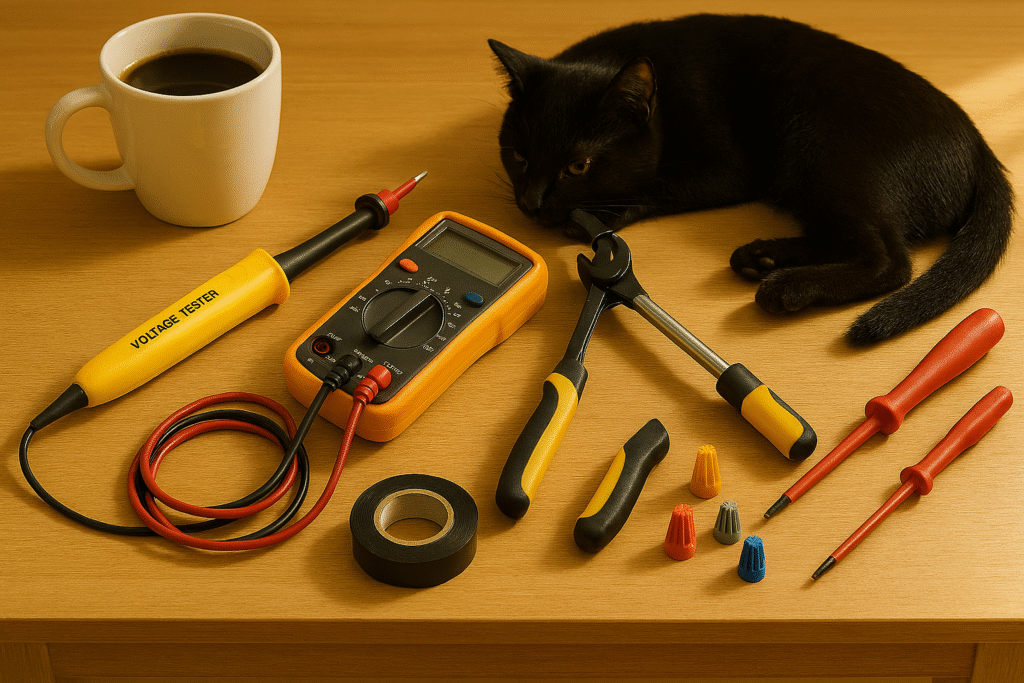
Because poking wires with a butter knife is not a long-term strategy.
Whether you’re replacing a light switch, installing a new outlet, or just trying to figure out why your ceiling fan sounds like a helicopter about to take off, having the right electrical tools makes all the difference. The good news? You don’t need to own a power company to get started—just a handful of reliable tools (and maybe a little coffee for courage).
Below is a breakdown of beginner-friendly electrical tools every DIYer should have in their kit. I’ve added links to solid, affordable options—because nothing’s more shocking than overpriced tools.
1. Voltage Tester (a.k.a. “The Don’t Get Zapped Stick”)
Before touching any wire, you’ll want to make sure it’s not live. A voltage tester tells you whether electricity is flowing, which is the difference between finishing your project or suddenly learning what “jazz hands” feel like involuntarily.
👉 Klein Tools Non-Contact Voltage Tester (Amazon)
2. Multimeter
This is the Swiss Army knife of electrical tools. A multimeter checks voltage, continuity, and resistance. Translation: it helps you figure out if your circuit is working, or if you’ve just invented the world’s most useless lamp.
👉 AstroAI Digital Multimeter (Amazon)
3. Wire Strippers
Forget using your teeth (seriously, don’t). A wire stripper cleanly removes insulation so you can connect wires properly. Bonus: they also make you look like you know what you’re doing, even if you just Googled “how to wire an outlet” five minutes ago.
👉 IRWIN VISE-GRIP Wire Stripper (Amazon)
4. Insulated Screwdrivers
Regular screwdrivers work… until they don’t. Insulated screwdrivers add an extra layer of safety so you can tighten terminals without playing “guess the current.”
👉 Wiha Insulated Screwdriver Set (Amazon)
5. Electrical Tape
Think of this as the duct tape of the electrical world. It insulates, protects, and makes your wiring look slightly less like a tangled rat’s nest.
👉 3M Scotch Super 33+ Vinyl Electrical Tape (Amazon)
6. Wire Nuts (a.k.a. “The Plastic Hats for Wires”)
These little caps keep wire connections safe and secure. Without them, your wires could shake loose—and surprise! That’s how haunted light switches are born.
👉 Gardner Bender Wire Connectors (Amazon)
Pro Tip: Safety First, Ego Second
Even with the right tools, always shut off the breaker before working. If you’re unsure about a project, call a licensed electrician. Because as much fun as DIY is, electricity doesn’t care about your YouTube tutorial streak.
FAQ: Electrical Tools & DIY Safety
Q: Can I get electrocuted changing a light switch?
A: Yes—if you don’t shut off the breaker first. Electricity is fast, invisible, and does not care that you once passed eighth-grade science. Always cut the power and test with your voltage tester before touching wires.
Q: Do I really need insulated screwdrivers?
A: Only if you’d like to keep your hair the same style it was before the project. Insulated tools give you a margin of safety that regular screwdrivers don’t.
Q: What’s the difference between a voltage tester and a multimeter?
A: A voltage tester answers one question: “Is this wire live?” A multimeter answers three questions: “Is it live? How much juice is flowing? And did I wire this correctly or create modern art?”
Q: Can I just twist wires together without wire nuts?
A: You could… if you enjoy electrical fires, flickering lights, and explaining to your insurance company why you skipped a 5¢ solution. Use the wire nuts.
Q: What’s the most important electrical tool for beginners?
A: Honestly? Common sense. If you’re not confident, don’t wing it—hire an electrician. Electricity is not forgiving, and it doesn’t care how many DIY videos you’ve watched.
